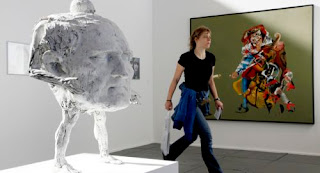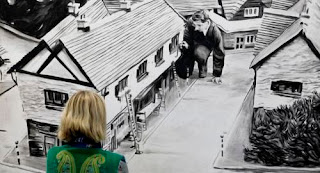ARTSPEAK
Artspeak a.p.a.s. is a resource developed to share current visual art news, reviews, links and exhibitions with those participating in the Advanced professional art studies program at CAE Degraves St, Melbourne and other interested students.
Saturday, November 13, 2010
Project for A.P.A.S students
Back from Oversea's
Hi. I am back from a fantastic trip oversea's and would like to share with you
some photo's of recent artworks on view currently from Berlin and New York.
Please comment and ask questions and I will respond Cheers XJo
Saturday, August 21, 2010
Born 1936, Ballarat, died 1999, Melbourne
With a career spanning three decades, Davis was one of Australia’s pre-eminent artists, a sculptor who regularly exhibited in Australia and overseas, particularly Japan and the United States. Davis represented Australia at the 38th Biennale of Venice and the Indian Triennale in 1978, and the Osaka Triennale in 1992. His ongoing concern for landscape resulted in numerous site-specific installation works in Australia, Saudi Arabia, Germany, Britain, the United States, Japan and New Zealand. Significant commissions include an installation in the Australian Embassy in Riyadh, Saudi Arabia. Davis’s work is represented in all Australian national and state galleries, most regional galleries, and in private and public collections in Australia and abroad. He was the recipient of various grants, overseas residencies and prestigious awards, including the Comalco Award in 1970 and the Blake Prize for Religious Art in 1993.
Davis drew inspiration from the Australian bush, particularly the Mallee country, the Hattah Lakes area and the Murray River, the artist often returning to these areas to create ephemeral works in situ. Recurring motifs in his work include rivers and fish, often referred to by the artist as nomads/travellers. Davis deeply respected Aboriginal art and culture, successfully establishing various collaborative projects and exchanges with local aboriginal people. Influenced by the Arte Povera movement and eschewing then fashionable metal sculpture, Davis worked with delicate materials, painstakingly modelling eucalyptus twigs, string, paper, calico and bitumous paint. His work and his many years of lecturing have been highly influential to the current generation of installation artists and sculptors.
Also evident in Davis’s work is his ongoing interest in Japanese forms and traditions, his first visit to Japan in the early 1980s resulted in an ongoing dialogue and relationship with that country and many of its significant artists. His contemplative solo practice was situated within thewider parameters of his exchanges and dialogues with cultures and locations, creating work rich in associations and vocabularies.
The works at the John Davis exhibition
Thursday, July 29, 2010


The term “gray area” speaks to a condition of indeterminacy, a liminal state in which something is not clearly defined or perhaps impossible to define. Julie Mehretu (b. 1970, Addis Ababa, Ethiopia) adapts such an enigmatic circumstance as a tool to engage the viewer in her complex compositions of meticulously drawn mechanical renderings, spontaneous gestural markings, and colorful interjections. The images seem to exist at a horizon where the work could either plunge into dense obscurity or nearly disappear into an ethereal cloud of dust. Yet a remarkable sense of pictorial space always exists in Mehretu’s paintings, created not just by their layering but also by the contrasts inherent in them. What appears abstract from afar is replete with detailed drawing when viewed up close. And just as one is able to glean some bit of information in order to identify a rendering, it vaporizes into an indefinability that compels the viewer to look again and again.
The paintings in this exhibition were produced as the 15th commission of Deutsche Bank and the Solomon R. Guggenheim Foundation. Inspired in part by Berlin, the city in which Mehretu created the works, the paintings evoke the psychogeography of a place and the effects of the built environment on individuals, while at the same time contemplating the past and the surviving traces of lived history. Walking through Berlin, where one still encounters the vestiges of war, an American such as Mehretu might recall that such destruction is currently perpetrated in the conflicts in Afghanistan and Iraq. A society at war often does not think of the lasting effects of its actions, and to see memories preserved after decades of recovery is a poignant reminder. These paintings are imbued with the ghostly traces of past and current transformations in the urban landscape.

Completed in 1959, the Guggenheim's Frank Lloyd Wright–designed museum is among the 20th century's most important architectural landmarks. The museum's great rotunda has been the site of many celebrated special exhibitions, while its smaller galleries are devoted to the Guggenheim's renowned collection, which ranges from Impressionism through contemporary art.





















